 W
WAbarsas was an ancient district in present-day southern Iran. It is first mentioned in the early 3rd-century as part of the fief of the Parthian dynast Mihrak. In 222, his fief was conquered by the Sasanian king Ardashir I, who two years later had it incorporated into the administrative division of Ardashir-Khwarrah.
 W
WAmghishiya was a Sasanian city or fortress located near the former Lakhmid capital of al-Hira. It was known as a major defensive headquarter. In 633, during the Muslim conquest of Persia, a battle took place in one of its satellite military posts, Ullais, where the Muslim Arabs defeated a combined army of Sasanian-Christian Arab troops. Amghishiya was thereafter invaded and sacked by the Muslim military officer Khalid ibn al-Walid, while the survivors of the place fled to the countryside.
 W
WArrajan (Arjan) was a medieval Persian city located between Fars and Khuzestan, which was settled from the Sasanian period until the 11th century. It was the capital of a medieval province of the same name, which corresponds to the modern-day Behbahan of Khuzestan Province, Iran.
 W
WBarda is the capital city of the Barda Rayon in Azerbaijan, located south of Yevlax and on the left bank of the Tartar river. It was the capital of Caucasian Albania perhaps since the end of the fourth century, Barda became the chief city of the Islamic province of Arran, the classical Caucasian Albania, remaining so until the tenth century.
 W
WBezabde or Bazabde was a fortress city on the eastern Roman frontier. Located in Zabdicene, it played a role in the Roman-Persian Wars of the 4th century. It was besieged two times in 360, narrated in detail by Ammianus Marcellinus. The Sasanians led by Shapur II captured Bezabde, despite adamant resistance from three Roman legions and local archers. The Roman counterattack led by Constantius II failed, but it returned in Roman hands after the Sasanians withdrew. Bezabde was ceded to the Sasanians by the Perso-Roman Peace Treaty of 363, after which it disappeared from historical records.
 W
WBishapur was an ancient city in Sasanid Persia (Iran) on the ancient road between Persis and Elam. The road linked the Sassanid capitals Estakhr and Ctesiphon. It is located south of modern Faliyan in the Kazerun County of Pars Province, Iran.
 W
WBokht-Ardashir was the name of a medieval town in the Sasanian province of Pars. It was founded in the early 3rd-century by the first Sasanian king Ardashir I after his flight from the court of the last Parthian king, Artabanus V. In 224, it was incorporated into the administrative division of Ardashir-Khwarrah.
 W
WThe Complex of Izadkhast is located in Izadkhast in the Fars Province of Iran, roughly 135km south of Isfahan. It is a historical complex listed in the UNESCO World Heritage Tentative List. The complex consists of the Izad-khast Castle and old ruined town, the Izadkhast Caravanserai roadside inn, and a Safavid-period bridge. The complex is located on a natural base with the castle built on a bedrock to protect it from foreign attacks. The architecture of the complex displays unique characteristics to Izadkhast.
 W
WCtesiphon was an ancient city, located on the eastern bank of the Tigris, and about 35 kilometres (22 mi) southeast of present-day Baghdad. Ctesiphon served as a royal capital of the Iranian empire in the Parthian and Sasanian eras for over eight hundred years. Ctesiphon remained the capital of the Sasanian Empire until the Muslim conquest of Persia in 651 AD.
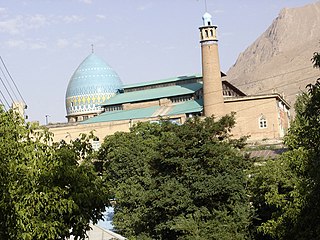 W
WDamavand is a city and capital of Damavand County, Tehran Province, Iran.
 W
WDarab — formerly Darábghird, or Darábgerd — is a city and capital of Darab County, Fars Province, Iran. At the 2006 census, its population was 54,513, in 13,279 families.
 W
WDastagird, was an ancient Sasanian city in present-day Iraq, and was close to its capital, Ctesiphon.
 W
WDerbent, formerly romanized as Derbend, is a city in the Republic of Dagestan, Russia, located on the Caspian Sea. It is the southernmost city in Russia, and it is the second-most important city of Dagestan. Population: 119,200 (2010 Census); 101,031 (2002 Census); 78,371 (1989 Census).
 W
WDvin was a large commercial city and the capital of early medieval Armenia. It was situated north of the previous ancient capital of Armenia, the city of Artaxata, along the banks of the Metsamor River, 35 km to the south of modern Yerevan. The site of the ancient city is currently not much more than a large hill located between modern Hnaberd and Verin Dvin, Armenia. Systematic excavations at Dvin that have proceeded since 1937 have produced an abundance of materials, which have shed light into the Armenian culture of the 5th to the 13th centuries.
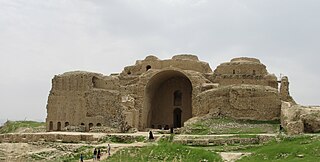 W
WFiruzabad is a city and capital of Firuzabad County, Fars Province, Iran. At the 2006 census, its population was 58,210, in 12,888 families. Firuzabad is located south of Shiraz. The city is surrounded by a mud wall and ditch.
 W
WGanzak, is an ancient town founded in northwestern Iran. The city stood somewhere south of Lake Urmia, and it has been postulated that the Persian nobleman Atropates chose the city as his capital. The exact location, according to Minorsky, Schippmann, and Boyce, is identified as being near Leylan, Malekan County in the Miandoab plain.
 W
WGonabad is a city and capital of Gonabad County, in Razavi Khorasan Province, Iran. At the 2011 census, its population was 36,367, in 10,389 families. Jūymand is an affluent northern district/suburb of Gonabad.
 W
WGundeshapur was the intellectual centre of the Sassanid Empire and the home of the Academy of Gundishapur, founded by Sassanid king Shapur I. Gundeshapur was home to a teaching hospital and had a library and a centre of higher learning. It has been identified with extensive ruins south of Shahabad, a village 14 km south-east of Dezful, to the road for Shushtar, in the present-day province of Khuzestan, southwest Iran.
 W
WHatra was an ancient city in the Nineveh Governorate of present-day Iraq. The city lies 290 km (180 mi) northwest of Baghdad and 110 km (68 mi) southwest of Mosul.
 W
WHulwan was an ancient town on the Zagros Mountains in western Iran, located on the entrance of the Paytak Pass, nowadays identified with the town of Sarpol-e Zahab.
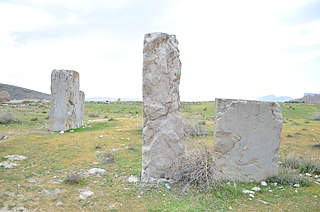 W
WIstakhr was an ancient city in Fars province, five kilometres north of Persepolis in southwestern Iran. It flourished as the capital of the Persian Frataraka governors and Kings of Persis from the third century BC to the early 3rd century AD. It reached its apex under the Sasanian Empire, and was the hometown of the Sasanian dynasty. Istakhr briefly served as the first capital of the Sasanian Empire from 224 to 226 AD and then as principal city, region, and religious centre of the Sasanian province of Pars. During the Arab conquest of Iran, Istakhr was noted for its stiff resistance, which resulted in the death of many of its inhabitants. Istakhr remained a stronghold of Zoroastrianism long after the conquests, and remained relatively important in the early Islamic era. It went into gradual decline after the founding of nearby Shiraz, before being destroyed and abandoned under the Buyids. Cursorily explored by Ernst Herzfeld and a team from the University of Chicago in the first half of the 20th century, much of Sasanian Istakhr remains unexcavated.
 W
WIzadkhast is a city in the Central District of Abadeh County, Fars Province, Iran. At the 2006 census, its population was 7,366, in 1,803 families.
 W
WKangavar is a city and capital of Kangavar County, Kermanshah Province, Iran. At the 2006 census, its population was 48,901, in 12,220 families.
 W
WKarka d-Ledan, also known as Eranshahr-Shapur, and Eran asan kar(t) Kavad, was one of the four Sasanian major cities of Khuzestan. It was (re)founded by King of Kings (shahanshah) Shapur II in 338, who had a winter palace established in the city. Karka d-Ledan is identified with the modern site of Ivan-e Kerkha.
 W
WKashmar is a city and the capital of Kashmar County, in Razavi Khorasan Province, Iran. Cahitu is located near the river Sish Taraz in the western part of the province, and 217 kilometres (135 mi) south of the province's capital Mashhad, in Iran, from east to Bardaskan, west to Torbat-e Heydarieh, north to Nishapur, south to Gonabad. Until two centuries ago, this city was named Torshiz (ترشیز). At the 2006 census, its population was 81,527, in 21,947 families.
 W
WKazeroon is a city and capital of Kazeroon County, Fars Province, Iran. In 2016, as the fifth big city in the province, its population was 96,683. Its agricultural products include date palms, citrus orchards, wheat, tobacco, rice, cotton, and vines.
 W
WKhunapakan was the name of a medieval district in the Sasanian province of Pars. It is mentioned as a district of the administrative division of Ardashir-Khwarrah in the Madigan-i Hezar Dadistan.
 W
WAl-Mada'in was an ancient metropolis on the Tigris River which lay between the ancient royal centers of Ctesiphon and Seleucia. It was founded during Sasanian rule, and was used as a synonym for Ctesiphon by the Arabs, and later by the Muslims.
 W
WMahan is a city and capital of Mahan District, in Kerman County, Kerman Province, Iran. At the 2006 census, its population was 16,787, in 4,138 families.
 W
WMarw-Rud or Marw al-Rudh, locally used to be known by the older variants Marwarudh (مروروذ) and Marrudh (مروذ), was a medieval settlement in Khurasan. It was also known as Marw-i Kuchik to distinguish it from the nearby Marw al-Shahijan or Greater Marw.
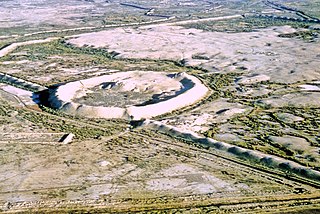 W
WMerv ; Macedonian-Greek Alexandria and Hellenistic Antiochia in Margiana was a major Iranian city in Central Asia, on the historical Silk Road, located near today's Mary in Turkmenistan. Several cities have existed on this site, which is significant for the interchange of culture and politics at a site of major strategic value.
 W
WNehardea or Nehardeah was a city from the area called by ancient Jewish sources Babylonia, situated at or near the junction of the Euphrates with the Nahr Malka, one of the earliest centers of Babylonian Judaism. As the seat of the exilarch it traced its origin back to King Jehoiachin. According to Sherira Gaon, Jehoiachin and his coexilarchs built a synagogue at Nehardea, for the foundation of which they used earth and stones which they had brought, in accordance with the words of Psalms 102:15, from Jerusalem. For this reason it was called 'The Synagogue that Slid and Settled'. This was the synagogue called "Shaf we-Yatib," to which there are several references dating from the third and fourth centuries was the seat of the Shekhinah in Babylonia. The Aaronic portion of the Jewish population of Nehardea was said to be descended from the slaves of Pashur ben Immer, the contemporary of King Jehoiachin.
 W
WNishapur or Nishabur is a city in Razavi Khorasan Province, capital of the Nishapur County and former capital of Khorasan Province, in northeastern Iran, situated in a fertile plain at the foot of the Binalud Mountains. It had an estimated population of 239,185 as of 2011 and its county 433,105. Nearby are the turquoise mines that have supplied the world with turquoise for at least two millennia.
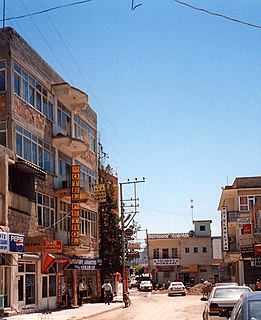 W
WNusaybin is a city in Mardin Province, Turkey. The population of the city is 83,832 as of 2009 and is predominantly Kurdish. In Turkish Kurdistan, Nusaybin is separated from the larger Kurdish-majority city of Qamishlo by the Syria–Turkey border.
 W
WAnbar also known by its original ancient name, Peroz-Shapur, was an ancient and medieval town in central Iraq. It played a role in the Roman–Persian Wars of the 3rd–4th centuries, and briefly became the capital of the Abbasid Caliphate before the founding of Baghdad in 762. It remained a moderately prosperous town through the 10th century, but quickly declined thereafter. As a local administrative centre, it survived until the 14th century, but was later abandoned.
 W
WQumis, also known as Hecatompylos was an ancient city which was the capital of the Arsacid dynasty by 200 BCE. The Greek name Hekatompylos means "one hundred gates" and the Persian term has the same meaning. The title was commonly used for cities which had more than the traditional four gates. It may be understood better as the "Many Gated". Most scholars locate it at Sahr -e Qumis, in the Qumis region in west Khurasan, Iran.
 W
WRamhormoz (Persian: رامهرمز; also Romanized as Rāmhormoz and Rām Hormuz; also known as is the capital city of Ramhormoz County, Khuzestan Province, Iran. At the 2006 census, its population was 49,822, in 10,966 families.
 W
WSamarkand, also known as Samarqand and Markanda, is a city in southeastern Uzbekistan and one of the oldest continuously inhabited cities in Central Asia. There is evidence of human activity in the area of the city from the late Paleolithic Era, though there is no direct evidence of when Samarkand was founded; some theories propose that it was founded between the 8th and 7th centuries BC. Prospering from its location on the Silk Road between China and the Mediterranean, at times Samarkand was one of the largest cities of Central Asia.
 W
WSeleucia, also known as Seleucia-on-Tigris or Seleucia on the Tigris, was a major Mesopotamian city of the Seleucid, Parthian, and Sasanian empires. It stood on the west bank of the Tigris River opposite Ctesiphon, within the present-day Baghdad Governorate in Iraq.
 W
WSusa was an ancient city in the lower Zagros Mountains about 250 km (160 mi) east of the Tigris River, between the Karkheh and Dez Rivers. One of the most important cities of the Ancient Near East, Susa served as the capital of Elam and the Achaemenid Empire, and remained a strategic centre during the Parthian and Sasanian periods.
 W
WValashabad, known in Greek sources as Vologesocerta, and in Arabic sources as Sabat (ساباط), was an ancient city in present-day Iraq, and formed a suburb of Ctesiphon, the capital of the Parthian Empire and their successors, the Sasanian Empire.
 W
WVeh-Ardashir, was an ancient Sasanian city in present-day Iraq, and formed a suburb of their capital, Ctesiphon.
 W
WVeh-Kavat, known in Islamic sources as Bih-Qubadh, was an administrative district within the Sasanian province of Asuristan and is known to have survived the Arab conquest of the Sasanian Empire and existed as a district until the 9th century AD at the least.